Farm workers in Scottish agriculture: case studies
Case studies examining farm workers in Scottish agriculture and the international seasonal migrant labour market.
3 Trends and number of seasonal migrant workers
Section Summary:
Farmers emphasised the critical role seasonal migrant labour played in their businesses, with the majority stating they would cease to operate or substantially reduce their activities should this labour be unavailable.
The country of origin for seasonal workers have shifted as a result of the opening up of the EU, the closure of SAWS and the advancement of key member state economies; Bulgaria and Romania currently provide the majority of seasonal farm workers in Scotland. Additionally, the average age of seasonal workers was perceived as having increased in recent years and the average quality (picking efficiencies) as having declined.
A decline in the availability of seasonal agricultural migrant workers was widely recognised by farmers as having occurred in 2017. Recruitment agencies also reported a significant increase in requests (15-20%) for labour and experienced shortfalls (of 10-15%) in their capacity to provide workers to farmers.
No alternative UK-based labour source was recognised as currently existing – with the decline of UK-based workers in seasonal farm jobs linked to multiple factors, including an increasing emphasis on high quality fresh fruit (and supermarket supply chains), regulatory changes and a de-valuing of seasonal farm jobs.
Current horticultural systems have evolved into high efficiency deadline-driven systems, which require a highly motivated, flexible and experienced workforce. Returnees represented the cornerstone of this workforce on most farms; this component is higher on farms with direct recruitment mechanisms, longer seasons and strong reputations. Returnees play a role in referring new workers to farms, an important recruitment tool on most farms.
The demand for seasonal workers is driven by the Scottish horticulture sector, peaking in the summer months (July and August) to coincide with the height of the soft fruit harvest. The need for seasonal workers does, however, extend throughout the year, particularly in the vegetable and potato sectors.
It is conservatively estimated that there were 9,255 seasonal migrant workers engaged in Scottish agriculture during 2017. This includes an estimated 900 workers of non- UK origin under the employment of registered labour providers that supply contract labour to farms across Scotland.
Labour providers (‘gangmasters’) play a pivotal role in Scottish agriculture, providing workers at short notice to conduct a wide variety of tasks on farms (from stone picking to hoof trimming, fruit and vegetable harvesting to farm maintenance, potato grading to tractor driving). Labour provider workforces are particularly important for vegetable planting and harvesting and in potato harvesting, grading and packing.
Labour providers often deal with small labour demands from farms with broad geographic coverage meaning logistical planning can be challenging to ensure appropriately skilled workers are available – something that was reported to be a challenge during some peak harvest periods where “ everyone is scrambling to get their crop harvested before it is too late.”
3.1 Background literature
British agriculture has long relied on international workers to satiate the demand for labour (Collins, 1976). The 1990s saw a general trend of increased employment of foreign nationals across various sectors, and past studies have confirmed that this labour pool is especially important to the agricultural industry (Dench et al., 2006).
On 1 May 2004, eight countries acceded to the EU. This opened the UK’s labour market to residents of the Czech Republic, Estonia, Hungary, Latvia, Lithuania, Poland, Slovakia and Slovenia (collectively known as the ‘A8’). Migrant worker inflows to the UK from the A8 countries since then have been substantial. By 31 December 2005, 10% of 345,000 workers from these eight countries had registered with employers in the agriculture or fishing sectors alone (Gilpin et al., 2006). The UK Government subsequently implemented the Worker Registration Scheme ( WRS) in an attempt to track how the British labour market would be affected by the A8’s ascension. During this period the ‘A2’ countries of Bulgaria and Romania also acceded to the EU.
The WRS recorded 1,133,950 registrations from May 2004 until the scheme closed in April 2011, with 17.3% and 12.6% of these workers going into the Scottish agriculture and food processing sectors respectively (McCollum et al., 2012). A8 migrants were also found to comprise a significantly higher proportion of the Scottish agricultural workforce than the UK generally with rural areas (Angus, Perth and Kinross, and Aberdeenshire) receiving the highest proportion of migrants.
According to the Office for National Statistics ( ONS) (2010), migration from Poland to the UK was the highest by far compared to the previous decade. Among A8 countries, Polish immigration was nearly nine times greater than the second highest country (Lithuania) between 2005 and 2009. Polish immigration to both the UK and Scotland was also the highest of all A8 countries over the lifetime of the WRS, although a higher percentage of Polish workers came to Scotland compared to the UK generally. Polish migration to Scotland peaked in early 2007, comprising about 80% of WRS registrations; however, it had declined to under 60% by late 2009 largely due to the 2008 recession and the opening up of the labour market to A2 workers. Migration to Scotland from Latvia, Lithuania and Hungary correspondingly increased over this period, which suggests that opportunities in A8 countries were “ likely to be significant ‘push’ factors in relation to migration” to Scotland (McCollum et al., 2012).
The economic downturn that followed the 2008 banking crisis decreased the overall need for migrant workers across all sectors. However, the decline in demand for foreign-born labour in agriculture and food processing was significantly smaller compared with other sectors, such as construction, hospitality and manufacturing. Findlay and McCollum (2013) highlighted the heavy economic losses that the horticulture sector suffered in 2008 due to labour shortages, leaving crops unpicked in the fields. Moreover, despite agriculture comprising less than 1% of UK jobs, “ data suggests that up to a quarter of all employees in this sector in 2011 could have been A8 workers”, underscoring the key role that these workers play in agriculture despite overarching market conditions (McCollum et al., 2012).
While Bulgaria and Romania acceded to the EU in 2007, they were not subject to WRS regulations. Instead, Bulgarian and Romanian workers were eligible for the Seasonal Agricultural Workers Scheme ( SAWS), which was restricted to these two countries after 2007 until the scheme closed in 2013 (Figure 3). SAWS also limited these workers to agriculture (whereas the WRS allowed A8 citizens to work in other sectors) and to a six month work period. From 2008 to 2012, between 15,000 and 20,000 new SAWS cards were printed annually for workers from Bulgaria and Romania that came to work in the UK, mostly in the horticulture sector and especially fruit-picking ( MAC, 2013).
Figure 3: Number of SAWS work cards issued in the UK by nationality, 2004-2012 [8]
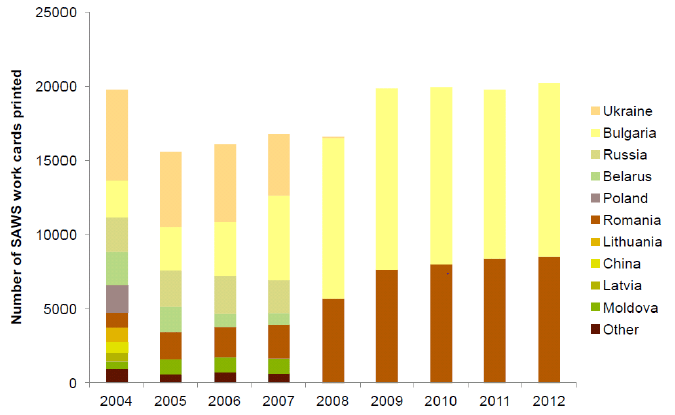
Source: Migration Advisory Committee (2013)
As with the WRS, SAWS registration totals in Angus, Perth and Kinross and Aberdeenshire were the highest of all local authorities in Scotland. MAC (2013) reported that in the 2012 season (up till 30 th September) 14.6% of the UK’s SAWS workers were in Scotland. The main regions where they were working were Angus (1,143 workers or 5.7% UK total), Perth and Kinross (966 workers or 4.8% of UK total), Fife (468 workers or 2.3% of UK total) and Aberdeenshire (292 workers or 1.3% of UK total)
Research conducted by the Gangmasters Licensing Authority ( GLA) [9] found that the number of agriculture workers employed (either directly or via Gangmasters) increased in every region of the UK except Northern Ireland after the SAWS scheme closed (Figure 4). They attributed this to several factors, such as: demand for labour exceeding the quota under SAWS; higher worker turnover; and greater worker availability. However, the report found that most farmers and growers were concerned about the Scheme’s closure, citing fears around “ increasing cost, customer demands and a fear of a lack of experienced and committed workers” (Gangmasters Licencing Authority, 2014).
Figure 4: Number of agricultural workers in UK before and after the cessation of SAWS
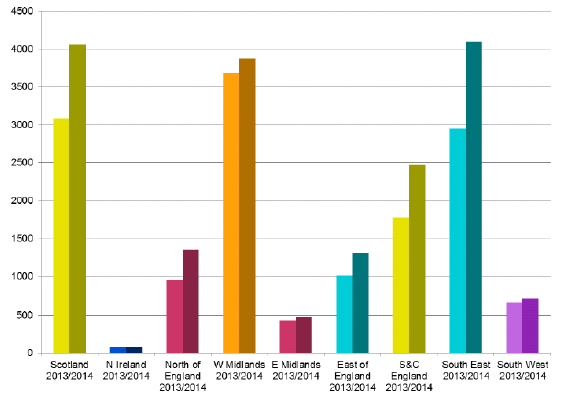
Source: Gangmasters Licencing Authority (2014)
The same report also included overall figures for agricultural migrant workers in Scotland both during and after the SAWS. They estimated that the number of workers increased by around 1,000 to just over 4,000 between 2013 and 2014, with the Bulgarians and Romanians making up the largest proportion of the workforces, although the proportion of workers from the rest of the EU also grew during this period. The GLA report also provided an indication of the seasonality of demand for workers with the majority having summer fruit pickers, although there is clear evidence of the spring flower picking season and the winter vegetable season in their analysis (see Figure 5).
Figure 5: Seasonality of Scottish Migrant Workers: 2014

Source: Adapted from Gangmasters Licencing Authority (2014)
Recent analysis of the 2015 JAC data in Scotland undertaken through the Rural Industries work package ( WP2.4) of the Scottish Government’s Strategic Research Programme (reported by Thomson et al., 2016) highlighted the horticulture sector’s particular reliance on seasonal migrant labour. The use of non- UK migrant labour in Scottish agriculture was reported to be heavily concentrated by:
- Sector: with 85% of migrant labour being in the horticulture sector, particularly the soft fruit industry (this sector accounts for nearly 10% of Scottish agricultural output
- Farm Size: with 87% of the migrant labour being used on large farms (more than 5 full time equivalents ( FTEs) when measured by standard labour requirement)
- Geography: with three quarters of Scotland’s migrant farm work utilised in Angus and Perth and Kinross. (Thomson et al., 2016).
An update of the distribution of seasonal migrant labour use and contract labour use from the 2017 JAC is provided in Table 2 where it is clear how important farms located in both Perth and Kinross (33%) and Angus (31%) were as employers of migrant labour. Over 93% of this 2017 seasonal migrant workforce was employed by large and very large farm businesses (over 4 Full Time Equivalent workers), with around 83% being used on soft fruit farms.
Table 2: Contract and Seasonal Migrant Labour use in Scottish Agriculture 2017
| Scotland | Contract labour | Migrant workers (i.e. non- UK nationals) |
|||||
|---|---|---|---|---|---|---|---|
| Holdings | Holdings | Work Days | % Work Days | Holdings | Work Days | % Work Days | |
| Scotland | 55,090 | 6,098 | 284,651 | 267 | 659,138 | ||
| Local Authority | |||||||
| Perth & Kinross | 2,488 | 370 | 25,388 | 9% | 38 | 217,733 | 33% |
| Angus | 1,341 | 214 | 13,042 | 5% | 59 | 201,176 | 31% |
| Aberdeenshire | 7,601 | 947 | 37,290 | 13% | 45 | 75,573 | 11% |
| East Lothian | 560 | 105 | 9,676 | 3% | 9 | 64,648 | 10% |
| Fife | 1,579 | 220 | 29,647 | 10% | 23 | 55,539 | 8% |
| Source: Scottish Government June Agricultural Census 2017 | |||||||
Whilst the JAC can provide estimates of migrant labour used on holdings, it does not readily permit estimation of the number of seasonal workers in Scottish agriculture due to, for example: seasonal employment being for different durations, or some individuals working on more than one holding in a season. The seasonal profile of labour within the Scottish soft fruit sector is likely to peak from May to August (as found by the GLA), but knowledge gaps prevent robust assessments of the true extent of migrant workers on Scottish farms.
Overall estimates for the total number of seasonal workers across the UK in recent years have ranged from 60,000 (Ruz and Stevens, 2016) to more than 80,000 ( NFU, 2016b), with the majority coming from central and Eastern European countries. Whilst robust statistics on numbers and nationalities of these migrants is far from certain, they have become a significant part of the British agricultural workforce (Cooke et al., 2011). This is especially the case in labour-intensive tasks such as harvesting, packing and primary processing of relatively high-value products such as fresh fruit, vegetables, salads and ornamental shrubs and flowers (Anderson et al., 2006). A comparison of employers’ use of migrant labour across a variety of sectors found that the structure of demand in the agricultural sector has unique characteristics. Firstly, the preference for migrant workers is much stronger in agriculture; and secondly, only in agriculture do employers unequivocally see migrant workers as “crucial” to their businesses (Dench et al., 2006).
3.2 The importance of migrant labour and key trends
Figure 6: Farmers’ seasonal worker employment preference
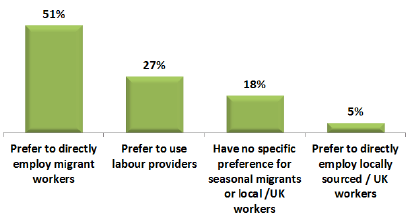
Results from the farm business survey revealed a general preference for migrant labour (see Figure 6), particularly in the horticulture sector, be it potatoes, calabrese, cauliflower, rhubarb, raspberries, strawberries, blueberries, daffodils, etc. Over half of the 79 respondents stated that they preferred to directly employ migrant workers (these tended to be businesses with high labour demand), with a consistent theme emerging that their work ethic is now preferred because they are “ motivated, reliable, hard-working and honest”. Over a quarter of respondents preferred to use labour sourced through labour providers and it is clear that these businesses have strong relationships with labour providers and consider it easier to deal with a reliable and reputable firm, particularly when the work is sporadic and very seasonal. Only 5% of respondents stated a preference for employing local or UK workers and these tended to have lower levels of worker demand overall. Around a fifth of businesses had no specific preference for the use of local or migrant labour, but the general sentiment is that the required local workforce no longer exists, as demonstrated by the following comments:
- “ I use migrants workers as there are not enough other workers to do the jobs needed.”
- “ I would prefer to directly employ local workers, but find this difficult, so tend to directly employ from overseas as well, and am happy with the quality of workers applying from overseas.”
- “ Without migrant labour my business would reduce by 80% as UK pickers would not start at 5am and pick solid for three months.”
The farm business survey had an open-ended question on the importance of seasonal migrant labour to the business. In particular the willingness to work for short periods (often less than six months) was cited as a major benefit of employing migrant workers. The level of feedback received reiterated how access to this workforce is absolutely vital to continuing the current scale of operation of Scotland’s soft fruit and field vegetable businesses in particular, because a reliable, motivated local labour pool appears to not exist, as the following comments suggest:
- “ We cannot see a scenario where local labour would be willing and able to work such that we could continue with our current operating model.”
- “Having access to seasonal labour is critical to our business. Without them we couldn't continue our business in the manner we currently do.”
- “We have no doubt that without seasonal migrant labour our fruit and vegetable production would have to reduce drastically and may have to cease completely.”
- “We need seasonal migrant workers help to pick and pack our crops; without this workforce we are in danger of being in position of not harvesting our crops.”
- “No seasonal labour ...no business! It’s that simple.”
Whilst it may appear that most of the workforce is engaged in harvesting activities the importance of seasonal workers in undertaking vital tasks throughout the year was also stressed, and potential mechanisation of key tasks was not seen as realistic solution. The following comments illustrate this attitude well:
- “Without this labour it would be hard to function efficiently as we use it for covering our crop in enviromesh and within our pack house all year round.”
- “ Mechanisation of these operations is the holy grail all growers are seeking, unfortunately although there are prototype machines in development around the world this is still many, many years from commercial reality.”
Indeed it appears that some farmers are already considering the future of their operations over concerns about access to migrant workers, as the following comments reveal:
- “Seasonal migrant labour is therefore absolutely essential to ensure [our crop] can be successfully harvested to meet the exacting standards of today’s retailers. This is a volatile crop which must be harvested in peak condition and which has a very short shelf life. Unless we are sure of availability of migrant labour then the crop will not be grown next year or in the future.”
- “We have found it much harder to source migrant labour this year and need SAWS in place for 2018 to give us confidence to plant the 2018 crop.”
- “Seasonal migrant labour has become an integral part of our business and we have come to rely on them for the timely harvest of our crops. Without them we would have to look very seriously at the cropping plan for this farm.”
During the interviews farmers from across all case studies corroborated the survey findings that the availability of seasonal migrant labour is fundamental to the long-term success of their businesses. Any substantial decrease in labour supply was directly linked with crop and income losses due to reduced harvesting capacity. Should migrant labour become unavailable, the majority of farms stated they would either cease to operate or be forced to reduce their activities substantially. As a result, current uncertainties around future labour supply were acknowledged as contributing to lower business confidence and delayed decisions on business investment [10] .
Farmers repeatedly identified seasonal migrant workers as highly motivated and ‘hungry for work’ due to a common focus on providing for their dependents. This motivation, combined with a high level of farm experience among many workers, was seen as facilitating highly efficient harvesting systems – a critical aspect for supplying supermarkets. Notably, labour providers and producer group interviewees highlighted the importance of migrant workers (seasonal and permanent) to all aspects of the agricultural supply chain, with a key link evident between seasonal workers on farms (providing raw product) and seasonal/permanent migrant workers in packhouses (preparing products for the market).
Farmers and wider stakeholders regularly stated that no local/ UK-based source of labour existed for them as an alternative to seasonal migrant labour. Often, farmers had engaged in local/Scottish recruitment; however this was seen as very challenging, with local workers difficult to source (despite repeated advertising efforts). Many farmers commented that unemployed people were very reluctant to lose their unemployment benefits in exchange for seasonal work.
Where local/ UK-based workers had been employed, some farmers stated that they demonstrated a relatively low work ethic and picking capacity, and retention was very low, with local/non-migrant workers sometimes failing to return to work after an initial period of work. Some farms had very small numbers (e.g. one to two people) of established British workers employed for seasonal work, and most received few enquiries from potential British workers. This position reaffirms the views of recruitment agencies/labour providers, who also stressed a very low level of interest in seasonal agricultural work from British nationals.
3.3 Estimate of the extent of the seasonal migrant workforce
In the farmer survey, businesses were asked to provide an overview of their labour use, including directly employed seasonal migrants (i.e. wages paid directly to employees rather than through a labour provider). Details were collected on the origin of workers, the monthly number of seasonal migrants employed and the number of work days per month.
Some cleaning and extrapolations were necessary where data was incomplete (e.g. number of monthly workers was included but not monthly workdays) or appeared inaccurate on cross-checking (e.g. every worker was reported as working 30 days per month). These adjustments were made using averages of businesses of similar scale and product mix. The estimated workdays for each business [11] were cross checked with the JAC data for 2017 and discrepancies investigated through various means (including using online business profile information and cross checking to details from interviews and conversations with major producers).
The 59 survey respondents that directly employed seasonal workers reported that they employed 8,200 seasonal migrant workers in 2016 [12] peaking at 6,300 in July with a low of 224 in January (see Figure 7). It was estimated that these workers undertook over 650,000 days of work on Scottish farms in 2016, peaking at 151,000 days in July and only 3,800 days in January.
The sector is very concentrated with 19 businesses reporting that they had more than 100 seasonal migrant workers directly employed – accounting for 90% of the workforce and days worked on these surveyed farms.
Figure 7: Seasonal migrant workers used and estimated work days on survey respondent’s farms
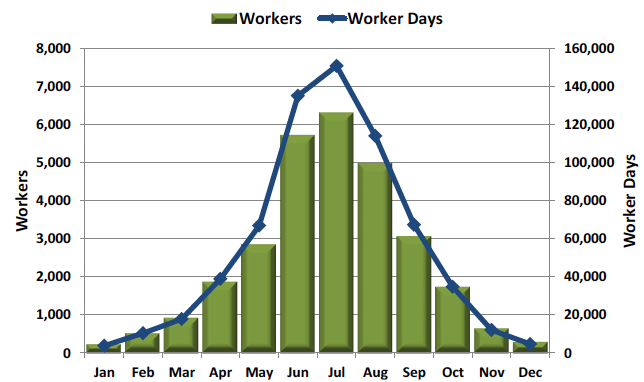
The worker survey and focus groups suggest that around three-quarters of seasonal migrant workers only work on one farm in any given season. However, it is unlikely that there is a great deal of inter-business worker movement (particularly due to the highly concentrated nature of the sector).Therefore we can assume that on these farms the lower bound of the seasonal migrant workforce is around 6,000.
The June Agricultural Census ( JAC) returns suggested that there were 659,000 workdays using seasonal non- UK labour on 267 holdings in 2017. Assuming the labour profile of the survey aligns to the JAC, this suggests a recorded seasonal migrant workforce of around 7,000. However, when the data for each survey respondent was aligned to the JAC it became apparent that some of the respondents reporting use of seasonal migrant labour had zero entries in the JAC. Specifically, five respondents reporting a combined 2,735 seasonal migrant workers undertaking 193,707 work days had zero entries in the JAC for their holdings/business. Additionally there were recording errors found in the JAC where it appears that the number of workers had been entered rather than the number of workdays (including for one of Scotland’s major horticulture producers that was estimated [13] to be employing over 500 migrant workers).
A key challenge in estimating the extent of seasonal migrant labour use in Scotland relates to complexities surrounding: (i) variance in the proportion of labour being directly employed on farms compared to that indirectly employed through labour providers; (ii) incomplete estimates of seasonal migrant labour provision in administrative databases; (iii) farm businesses leasing their land to specialist growers who undertake all of the farming activity (which does not appear in official databases but needs to be considered to prevent a gross overestimation); (iv) the transitory nature of some migrant labour – working on multiple farms.
Table 3: Estimated total seasonal migrant workforce engaged in Scottish agriculture
| Data | Scottish Area | Estimated Days | Worker Assumptions | Estimated Workers | Estimated Workers after churn | |
|---|---|---|---|---|---|---|
| Protected soft fruit | Survey Regression | 1,404 Ha | 892,485 | Average 4 months’ work 10% worker churn at peak season | 7,437 | 6,694 |
| Field fruits | ||||||
| Strawberry, Raspberry and Blueberries | Nix | 182 Ha | 75,535 | Average 3 months’ work 20% worker churn | 629 | 567 |
| Other Soft Fruit (including blackcurrants) | Survey Regression | 487 Ha | 6,428 | Average 4 months’ work 20% worker churn | 71 | 64 |
| Potatoes | Survey Regression | 29,285 Ha | 243,067 | Average 7 months and 30% churn from fruit | 1,157 | 810 |
| Flowers and Bulbs | Survey Regression | 964 Ha | 21113 | 3 months, 5% churn* | 235 | 223 |
| Vegetables | ||||||
| Cabbages | Nix | 278 Ha | 11,120 | Average 7 months and 30% churn from fruit | 93 | 65 |
| Calabrese | Nix | 1,794 Ha | 37,008 | Average 7 months and 30% churn from fruit | 308 | 216 |
| Cauliflower | Nix | 330 Ha | 6,643 | Average 7 months and 30% churn from fruit | 55 | 39 |
| Brussels Sprouts | Nix | 1,040 Ha | 48,105 | Average 7 months and 30% churn from fruit | 401 | 281 |
| Rhubarb | ADAS | 75 Ha | 330 | Average 1 month (20% churn)* | 11 | 9 |
| Other Veg for human consumption | Survey Regression | 16,028 Ha | 86,553 | Average 7 months and 30% LP churn from fruit | 412 | 289 |
| Total Seasonal Migrant Workforce | 10,811 | 9,255 | ||||
| *Low worker churn as specialist pickers | ||||||
Based on farmer and stakeholder comments an overall decline in seasonal labour availability occurred in 2017 and there was a note of concern from some survey respondents that in 2017 “ agencies are saying it is harder to find people willing to do this hard job” in Romania and Bulgaria. Some noted some impact, with declines evident in the number of returnees case study farms noted little or no change in labour availability (usually those with a small workforce or a very high returnee contingent). However, the majority of case study farms and referrals/invitees on some farms and most reporting a decline in the availability of labour they were able to access through recruitment agencies, with agencies failing to fulfil their labour requests. For example, one mixed farm failed to receive 50% of the requested numbers from two agencies and was only made aware of this shortfall at short notice.
Recruitment agency interviewees confirmed this view. Both Concordia and Hops (major agricultural recruitment agencies supplying seasonal agricultural labour) experienced a 15-20% increase in demand for seasonal labour (due to declines in returnee numbers and often at short notice), with both agencies failing to fully supply demand in 2017 (with a 10-15% shortfall on requests). In some cases these factors resulted in substantial pressure on existing farm workforces during peak periods, although case study farms did not report any extensive product losses due to these shortfalls. Recruitment agencies also reported increasing difficulties with in-country recruitment: agents were required to make an extra effort to recruit in Bulgaria and Romania, with the number of new recruits in these countries gradually being exhausted. Some farmers raised concerns in relation to a potential cumulative decline in the number of seasonal workers due to returnees gradually returning home permanently as they reach their goals, compounded by an ongoing decrease in the availability of new workers and leakage of workers to other sectors and countries.`
3.3.1 Long term changes in seasonal workers’ profile
Farmers and wider stakeholders acknowledged that harvesting had historically been done by Scottish workers. The movement away from using Scottish seasonal workers to the current, largely- EU profile has been occurring over the last 20 to 25 years, with one farmer commenting that:
- “ We are happy to use locally sourced UK labour, unfortunately none is available for this type of seasonal outdoor work (in all weather). Therefore we have used seasonal migrant workers since 2002. Prior to this all seasonal labour was local. Since then our requirements have more than doubled but local seasonal labour has all but disappeared.”
A number of key reasons were given, through survey responses and interviews, which help explain the shift from local labour sourcing to a reliance on seasonal foreign labour, illustrated by the following sentiments:
- “ The decline (15-20 years previously) of picking by local mothers with their children during school holidays, due to: (i) tighter controls over part-time/casual employment while claiming benefits; and (ii) a perception of children in the field as child labour, particularly with the increasing reliance of supermarket supply chains for fruit.”
- “ The introduction of the minimum wage in 1999 which complicated pay based on a piece rate system (i.e. those picking insufficient amounts to reach the minimum wage equivalent). This resulted in a gradual reduction of the casual (e.g. teenaged) workforce on fruit farms as the piece rate had facilitated a less regimented/casual working day where workers controlled their own output.”
- “Ongoing low unemployment, particularly in rural areas (with a geographic mismatch between farm labour demands and areas of unemployment), and a reluctance among the unemployed to risk losing their benefits for short-term seasonal work, combined with a need for seasonal staff to work flexible hours and have few commitments during the season (e.g. no dependents on-site).”
- “An increasing emphasis on supplying high quality fresh products directly to supermarkets and delivering to market deadlines, as opposed to supplying the processed/frozen fruit industry in the past. This has increased demand for high quality products and high efficiencies, requiring experienced teams capable of skilled, high output harvesting.”
- “A perception of harvesting work as demanding, often with early starts and a requirement to work in all weather conditions six days a week.”
- “An ongoing decline in interest among UK-nationals in employment within the agriculture sector in the UK and a devaluing of seasonal agricultural work, with the loss of a ‘picking culture’ among British nationals.”
There has been a constantly changing regional profile of the non- UK workforce, driven by political decisions - be they on EU accession, the right of movement for EU workers or restrictions introduced to the SAWS. Whilst workers’ country of origin was often not reported as a concern by the survey respondents, changing rules on UK labour market access clearly has knock-on effects at farm level due to: (i) the costs of recruitment in new countries; (ii) generating a reputation as a good place to work that leads to returnee workers (in new countries this invariably takes time and money and leads to inevitable bedding-in issues to overcome as new languages and cultures and behaviours are learned and adapted to).
A concern raised by a number of farms and confirmed by recruitment agency interviewees was an increase in the average age of workers in recent years and a decline in the ‘quality’ of workers. Students and workers in the 18-25 age group were seen as making up a declining component of the workforce on most farms (with some farms still employing reasonable student numbers) in recent years, with a majority on some of the case study farms now over 30-35, and with declining English language ability, less formal education and an increased number of workers picking at lower efficiencies. This was generally seen as linked to the availability of improved opportunities for students and young people in their home countries. As one mixed farmer explained, the shortage of workers “ meant that this year we were just happy to get any workers out on the fields picking the berries, no matter how good they were, as we could not afford to let anyone go this year”. Looking to the future, farmers also requested that if there were to be restrictions on EU nationals working in Scotland “ we have a very flexible and easy to implement SAWS scheme” to minimise disruption to their businesses.
3.3.2 Current nationality of the migrant labour workforce
Businesses reported that they had historically sourced most of their labour from Ukraine and Russia, then from Poland, the Czech Republic, Latvia, Lithuania, Slovakia, etc., whereas now they employ far more Bulgarians and Romanians (driven by changes to SAWS in 2007)(see Figure 8). In the minds of the Scottish employers there was a clear link between perceptions of relative wealth and worker expectations in Eastern European economies and the prevalence of their workers in Scottish agriculture (with agriculture often the entry route to working in another sector of the Scottish economy). In addition, there was a perception that the minimum wage means that there has been a move towards a much harder focus on worker output - away from foreign students looking for “working holidays” where they could have a more relaxed approach to work with pay being piece-rate, to the present where “ they are less inclined to come now as it’s no longer a holiday”.
Figure 8: Origin of farm business respondents’ seasonal migrant workforce, 2016
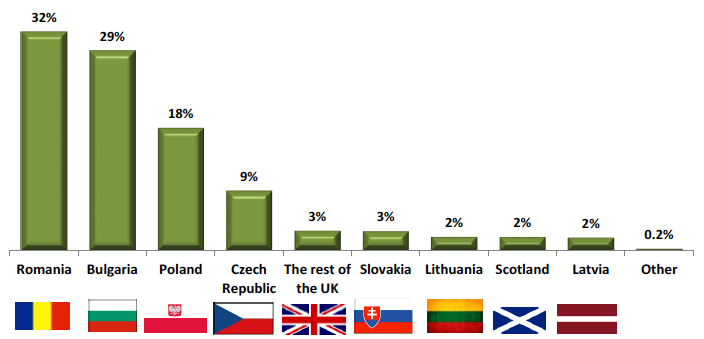
Foreign labour is therefore perceived as filling a major seasonal workforce requirement within the Scottish agricultural sector. The survey findings were corroborated by farmers and recruitment agencies during interviews. They collectively recognised Romanian and Bulgarians as representing the majority of the current seasonal migrant workforce (over 90% on some farms) due to the continued existence of an earnings and currency differential. Polish and Czech workers were recognised as being in decline, with a core of Polish returnees (and longer term migrants) gradually returning to Poland permanently in line with improvements to the Polish economy and the achievement of key earnings targets by these workers (e.g. to build/purchase a house in Poland).
Nevertheless, worker origins vary between farms, with Polish, Latvian, Czech and Lithuanian workers remaining an important labour component on some farms, as well as some Spanish and Italian workers. The recruitment agency and producer group interviewees further confirmed these trends, noting a substantial decline in the number of Polish migrants applying for permanent jobs in the UK.
3.3.3 The role of labour providers (gangmasters)
From the farmer perspective, labour providers provided a flexible source of temporary labour which could be obtained subject to need and harvest pressures, with farmers also able to request certain workers or worker teams based on prior experience.
However, in some instances it was difficult to ascertain the role of labour providers on farm businesses due to the varied nature of the labour supply business and their relationship with farmers. For example, some labour providers or ‘gangmasters’ represent an established form of contracted labour provision in UK agriculture (e.g. a labour provider is contracted to supply labour to cut field vegetables, grade potatoes or pick fruit on a given day). In other instances some labour providers are considered more as recruitment agencies that will source labour for farms for a contracted fee following a period of successful employment – many of these workers appear to then remain with farms.
Hence, these regulated ‘gangmasters’ play a dual role within the industry and for some farms they play a vital role in ensuring there is an adequate workforce for the daily (and highly varied) tasks on the farms. These ‘gangmasters’ are regulated by the GLAA and therefore are under regulatory scrutiny over issues such as health and safety, training, working hours, overtime, holidays and sick-pay, etc.
Many smaller businesses, or those in the vegetable and potato sectors, prefer to use labour providers as it provides them with labour flexibility. Regardless of preference, there was an underlying feeling that local labour is extremely difficult to source, particularly during peak periods, and that currently finding appropriate labour (migrant or local) was a challenge: “ We cannot stress how difficult it is to find farm staff; it puts pressure on what is a very understaffed business as it is.”
Over half the farm business survey respondents used labour providers to some extent. Figure 9 shows how much of each of these farms’ seasonal labour need was supplied by labour providers. More than half of those actively using labour providers used them for more than 70% of their total seasonal labour needs. Generally, those farms with high use of labour provider workforce were not large soft fruit growers, but rather a mix of potato and vegetable growers or smaller farm businesses. This finding aligns with the evidence gathered from interviews with stakeholders, farms and labour providers. That said, many specialist soft fruit farms clearly use labour providers at peak periods, for specific tasks, or as recruitment agencies.
Figure 9: Proportion of seasonal labour requirement fulfilled by labour providers (where used))
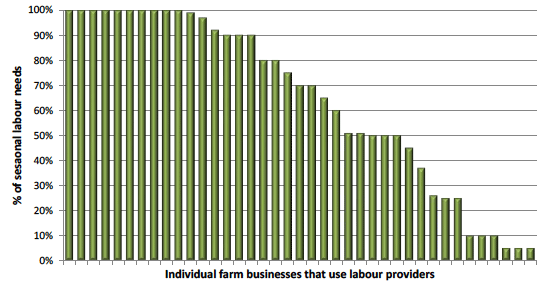
Workers employed through labour providers were used for a wide range of activities (see Table 4) and accounted for an average of 64% of all seasonal labour needs on those farms that use labour providers. Labour providers were used when there is a specific need, particularly during fruit and vegetable harvesting periods and associated processing and packaging. Labour providers also supplied workers for core activities around preparation, planting, plant husbandry and general maintenance on many farms. 82% of the farms that used labour providers reported that the workers were used for harvesting (accounting for an average of 61% of total seasonal labour needs for harvesting on these farms). Nearly 70% of farms reported that labour provider workers were used for processing/packing, and they accounted for an average of 50% of the seasonal labour need. A third of farms using labour providers utilised their workers for planting and husbandry tasks (potato and vegetable producers) with only a fifth of the labour provider users utilising the workers for maintenance work. This reveals the importance of labour provider workers to half the Scottish horticulture and potato sectors.
Table 4: Proportion of total seasonal labour undertaken by labour provider workers, by task in 2016 [14]
| Labour Provider supplied workers: | % farms that use labour providers | Average reported % of total seasonal labour use |
|---|---|---|
| Total seasonal labour needs | 64% | |
| Maintenance | 21% | 14% |
| Planting | 33% | 33% |
| Husbandry | 33% | 27% |
| Harvesting | 82% | 61% |
| Processing/packaging | 69% | 51% |
Reasons given for using labour providers included: reliability; convenience, particularly on satellite units remote from the core workforce; peace of mind in the recruitment process; continuity of supply, particularly during peak periods; specialist skills, short period of work that does not justify direct employment; taking care of the worker management/training/transport/social/ HR responsibilities, etc. Those with a preference for labour providers appear to have long-term working relationships with their provider. The typical type of response for favouring labour providers is summed up by sentiments such as:
- “ X are excellent and we have used them for many years now.”
- “Because of our very variable demand day to day it’s much easier to deal with one entity rather than many individuals.”
- “They guarantee the number you need, when they arrive and when they leave.”
Most of the case study farms rarely (if ever) used labour providers, with the main reasons being: i) poor cost-effectiveness of contracted labour (e.g. due to management fees) when used to address labour needs where margins were relatively narrow and labour needs were more long-term; ii) a perception that using labour providers may involve a risk of contravening laws relating to workers’ rights and reputational risks and; iii) less reliability and lower efficiency and work ethic of workers relative to in-situ established worker teams. In relation to the final point it should be noted that that the labour provider model was frequently recognised as working well for potato farms, where margins were somewhat higher and labour needs were often short term; workers also often returned to the same farms allowing for the building of trust and experience.
The survey of labour providers yielded 22 responses from a wide variety of businesses providing workers into Scottish agriculture [15] : contract labour for general agriculture, poultry, potatoes, cereal roguing, food processing etc., as well as recruitment agencies. This included 17 businesses that supplied labour to Scotland and were registered with the GLAA with 13 registered to supply workers to the agriculture sector, five to horticulture and eight for processing and packaging of all fresh food, drinks and other produce. About a quarter of these labour providers were also engaged in wider labour provision services, including to the: education, landscaping, recycling, distribution, logistics, non-food manufacturing, construction, hospitality and logistics, cleaning, warehousing, oil and gas, finance, quarry sectors.
Of the 14 businesses that supplied information, five were more than 90% reliant on the agriculture and horticulture sectors for their business. Another five had less than 5% reliance on these sectors. This reveals the disparate nature of these labour supply businesses with some having wide sectoral spread, being able to supply labour to Scottish agriculture on occasion if the contract is attractive. Other specialist suppliers to Scottish agriculture tend to have a workforce with good agricultural experience, prefer that line of work and will supply labour to farmers at a variety of scales and locations depending on need. These agricultural specialists appear to have strong relationships with their farming clients and work hard at recruiting and maintaining their workforce to be able to undertake a wide variety of tasks.
Of the 14 businesses providing data on their activities eight worked at ‘local’ level (up to 50 miles) with three working regionally (up to 100 miles) and three working nationally. Even though the number of respondents was low, it did provide some details of the farming sectors that labour is supplied to. In support of anecdotal evidence, it is clear that the field vegetable and potato sectors dominate (see Figure 10), with broad coverage of all other sectors which suggests some labour providers can supply workers to a range of farming sectors. The labour providers with more than 50% reliance on Scottish agriculture provide most labour to the potato sector, followed by the field vegetable sector with a couple of specialists providing labour for the daffodil flowerers/bulb sector.
Figure 10: Proportion of labour providers supplying workers to different Scottish agricultural sectors
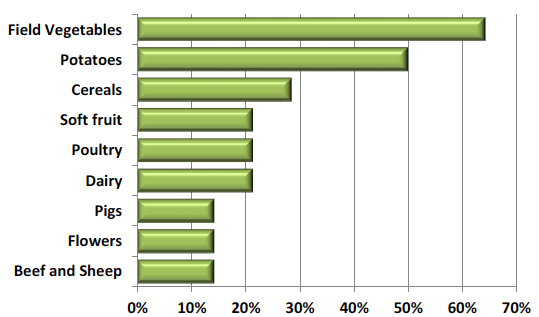
Interviews were conducted with three labour providers with further clarification provided by a medium sized labour provider. Labour provider interviewees commonly employed staff on temporary zero hours contracts and provided labour to farm businesses based on an hourly rate (which incorporates the workers rate of pay, plus additions for tax, national insurance, holiday pay and a management fee). In some cases larger labour providers also sub-contracted smaller local gangmasters to carry out work on their behalf. These businesses commonly provided labour in small (e.g. 2-6 workers) teams, with the larger ones providing labour to farms across a wider geographic region.
Labour providers were not generally being used by the case study fruit farms (with some occasional exceptions) due to the relatively low margins, higher intensity workloads and the requirement of high numbers of staff over relatively long periods. The main area of activity for the interviewed labour providers (and recognised as the main area of business for most agricultural labour providers in Scotland) was providing small teams to potato farms of all sizes for harvesting, grading and roguing potato crops, with the main season running from October through the winter months into Spring.
Labour providers employed both seasonal and more permanent staff, with a somewhat wider mix of nationalities (than fruit farms) evident as a result, including a minority of Scottish employees. Labour provider employees were required to have their own accommodation and were therefore usually more permanently located in Scotland or following a regular multi-season working pattern. The larger labour provider required workers to have their own transport (usually shared) to ensure they were able to travel to their place of work, while the smaller provider supplied transport and charged workers a daily fee to cover transport costs. The larger of the two interviewed labour providers operated an in-house recruitment agency (employing over 400 workers across Scotland on a temporary/seasonal basis), with the smaller firm employing predominantly permanent workers and recruiting via word of mouth. Some utilise workers that had been working in the fruit sector for the later potato and vegetable harvest seasons.
Discussions with labour providers suggest that they are equally under pressure to maintain services often on a ‘just-in-time’ basis, where labour demand is at short notice. The personal nature of some of Scotland’s specialist agricultural labour providers allows for this level of flexibility (putting two or more workers into multiple locations on a daily basis). The suggestion is that this approach to labour demand from farms means that it is difficult for labour providers to plan their staff workdays, and ensure that their workers have regular and fulfilling jobs to go to (they stress the importance of their workforce loyalty, as high turnover leads to high recruitment, training and administrative costs). Labour providers suggest that they are often ensuring that labour / wage laws are adhered to on farms and staff are paid overtime when due. Other challenges include managing peaks in demand for workers when crops mature together (e.g. calabrese) or seasonal peaks (e.g. Brussels sprouts at Christmas) which sometimes means there is inadequate supply if the weather causes phased plantings to need harvesting together.
Based on interviews and survey responses it is conservatively estimated that the main Scottish labour providers supplying contract workers to farms employ around 900 seasonal migrant workers annually. This figure is likely to include people that are working in other sectors as well as agriculture, and there is some blurring of boundaries between agricultural and food processing work.
Contact
There is a problem
Thanks for your feedback